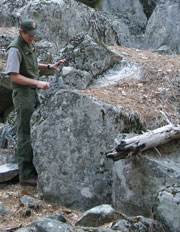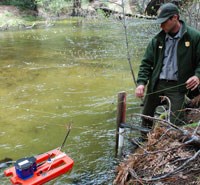|
Yosemite National Park inspires awe and wonder at the forces that have created its dramatic landscapes. Geologists, hydrologists, and geographers investigate and document the processes that shape them in order to get a holistic sense of this diverse ecosystem and environment, which ranges from below 3,000 feet to over 13,000 feet in elevation.

GeologyYosemite is a classic example of a glaciated landscape, where glaciers have carved the smooth domes of Tuolumne Meadows, the jagged high country peaks, and the dramatic walls of Yosemite Valley. This scenery was the basis for Yosemite's preservation as a national park. Granite, because of its durability and strength, preserves these bold forms. While glaciers have retreated from all but the highest peaks, Yosemite’s iconic cliffs continue to be shaped today by rockfall and other erosive processes. Learn More:

HydrologyYosemite is famous for its waterfalls, particularly the 2,425-foot Yosemite Falls—one of North America’s tallest. However, water shapes this landscape in myriad other ways. Winter snowpack is a major driver of the park’s hydrologic system, so it is carefully measured at 13 different courses with records dating back to 1931. Spring floods reshape the land during a natural house-cleaning that scours river channels and redistributes rock, soil, silt, and sand. Dry summers, especially at the lowest elevations, force plants to adapt to a lack of water and the presence of fire. Learn More:
Geography and Geographic Information System (GIS)Geography is both a natural and a cultural science, just as Yosemite is a site of incredible natural beauty as well as a rich cultural history. Mapping reveals the relationship people have with the spaces they inhabit. Complex mapping software, called geographic information systems, allows park scientists to carefully map and analyze Yosemite's 750,000 acres. By understanding where rockfalls occur most often or how fire behaves in these forests, scientists can assess management needs and protect the park and the people within it. Projections of climate change effects, for instance, reveal why wildlife and plants are moving higher in elevation to find suitable habitat. Learn More:
WildernessWilderness is a place unchanged by people: a place of solitude, a place of peace, a place of adventure and learning. Here, you will find no cars, no roads, no electricity, and no modern conveniences. Nearly 95 percent of Yosemite is congressionally designated wilderness, which, "in contrast with those areas where man and his own works dominate the landscape, is an area where the earth and its community of life are untrammeled by man, where man himself is a visitor who does not remain." Learn More:
Yosemite Observer Dashboard: Physical SciencesVisual, interactive information about current weather, stream flow, fires, and air quality conditions; all on one site! “I gloried in the magnificent setting in which I found myself, with crystal-clear lakes set in glacial basins adjacent to massive Mounts Ritter and Banner and the jagged Minarets of the Ritter Range—all of this and absolutely fascinating geology … sitting around the campfire … or lying on an outcrop watching shooting stars.” –N. King Huber, U.S.G.S. scientist and author of Geological Ramblings in Yosemite |
Last updated: January 17, 2024
